Page 73 of 521

Airbag Warning Light
The light should come on and remain on for six to eight
seconds as a bulb check when the ignition switch is first
turned ON. If the light is not lit during starting, see your
authorized dealer. If the light stays on, flickers, or comes
on while driving, have the system checked by an autho-
rized dealer.
Defroster
Check operation by selecting the defrost mode and place
the blower control on high speed. You should be able to
feel the air directed against the windshield. See your
authorized dealer for service if your defroster is
inoperable.
Periodic Safety Checks You Should Make Outside
The Vehicle
Tires
Examine tires for excessive tread wear and uneven wear
patterns. Check for stones, nails, glass, or other objectslodged in the tread. Inspect the tread and sidewall for
cuts and cracks. Check the wheel nuts for tightness.
Check the tires (including spare) for proper pressure.
Lights
Have someone observe the operation of exterior lights
while you work the controls. Check turn signal and high
beam indicator lights on the instrument panel.
Door Latches
Check for positive closing, latching, and locking.
Fluid Leaks
Check area under vehicle after overnight parking for fuel,
engine coolant, oil, or other fluid leaks. Also, if gasoline
fumes are detected or if fuel, power steering fluid, or
brake fluid leaks are suspected, the cause should be
located and corrected immediately.
THINGS TO KNOW BEFORE STARTING YOUR VEHICLE 71
2
Page 278 of 521
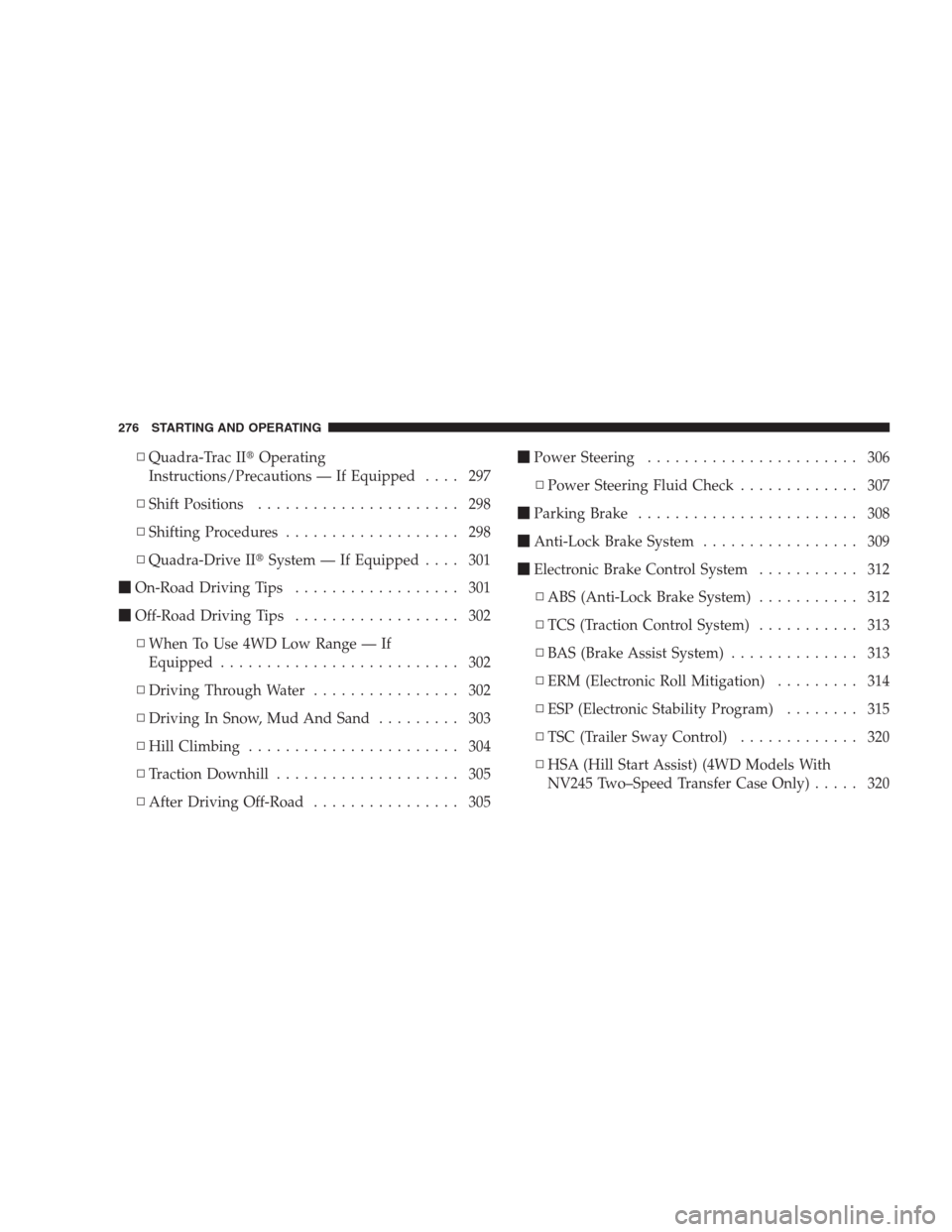
▫Quadra-Trac II�Operating
Instructions/Precautions — If Equipped.... 297
▫Shift Positions...................... 298
▫Shifting Procedures................... 298
▫Quadra-Drive II�System — If Equipped.... 301
�On-Road Driving Tips.................. 301
�Off-Road Driving Tips.................. 302
▫When To Use 4WD Low Range — If
Equipped.......................... 302
▫Driving Through Water................ 302
▫Driving In Snow, Mud And Sand......... 303
▫Hill Climbing....................... 304
▫Traction Downhill.................... 305
▫After Driving Off-Road................ 305�Power Steering....................... 306
▫Power Steering Fluid Check............. 307
�Parking Brake........................ 308
�Anti-Lock Brake System................. 309
�Electronic Brake Control System........... 312
▫ABS (Anti-Lock Brake System)........... 312
▫TCS (Traction Control System)........... 313
▫BAS (Brake Assist System).............. 313
▫ERM (Electronic Roll Mitigation)......... 314
▫ESP (Electronic Stability Program)........ 315
▫TSC (Trailer Sway Control)............. 320
▫HSA (Hill Start Assist) (4WD Models With
NV245 Two–Speed Transfer Case Only)..... 320
276 STARTING AND OPERATING
Page 308 of 521
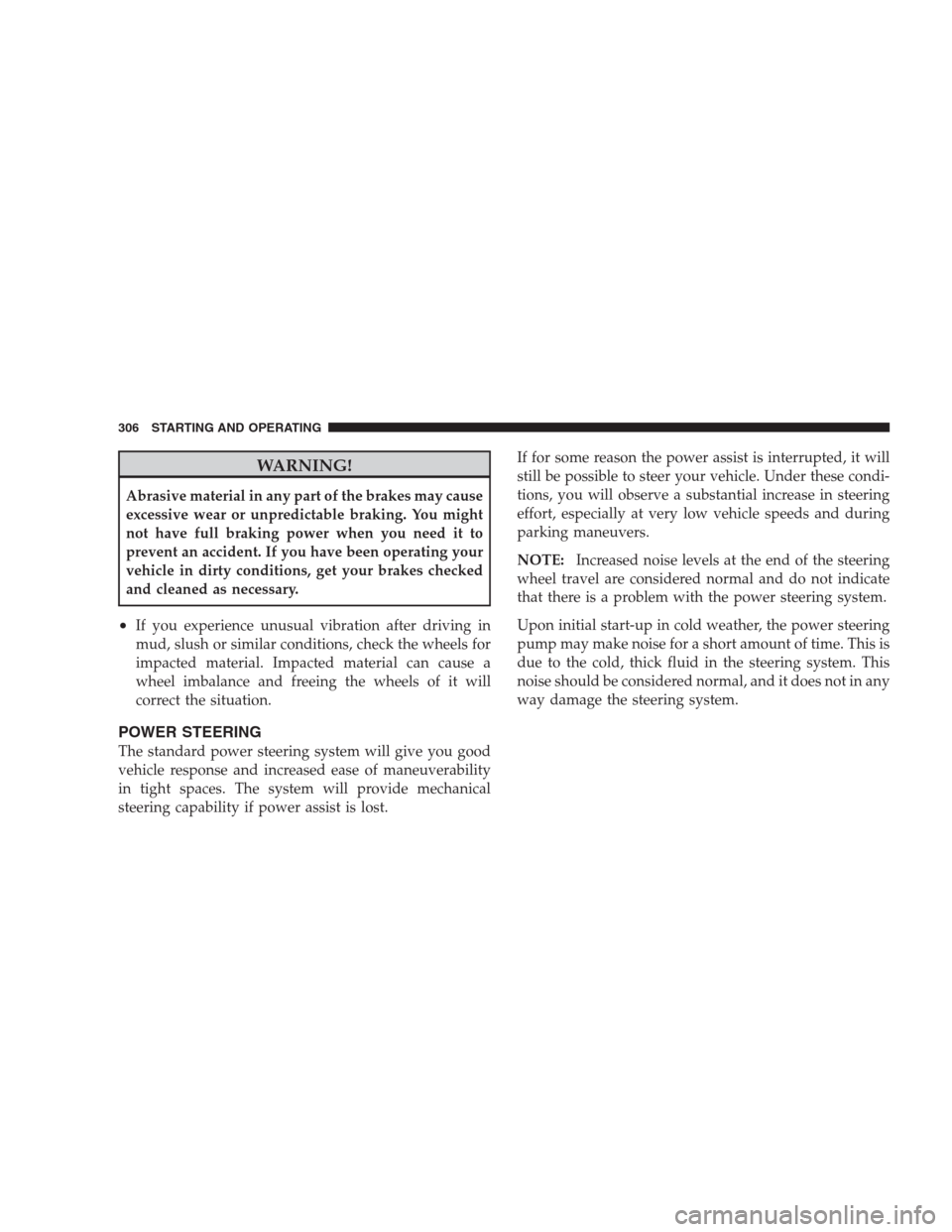
WARNING!
Abrasive material in any part of the brakes may cause
excessive wear or unpredictable braking. You might
not have full braking power when you need it to
prevent an accident. If you have been operating your
vehicle in dirty conditions, get your brakes checked
and cleaned as necessary.
•If you experience unusual vibration after driving in
mud, slush or similar conditions, check the wheels for
impacted material. Impacted material can cause a
wheel imbalance and freeing the wheels of it will
correct the situation.
POWER STEERING
The standard power steering system will give you good
vehicle response and increased ease of maneuverability
in tight spaces. The system will provide mechanical
steering capability if power assist is lost.If for some reason the power assist is interrupted, it will
still be possible to steer your vehicle. Under these condi-
tions, you will observe a substantial increase in steering
effort, especially at very low vehicle speeds and during
parking maneuvers.
NOTE:Increased noise levels at the end of the steering
wheel travel are considered normal and do not indicate
that there is a problem with the power steering system.
Upon initial start-up in cold weather, the power steering
pump may make noise for a short amount of time. This is
due to the cold, thick fluid in the steering system. This
noise should be considered normal, and it does not in any
way damage the steering system.
306 STARTING AND OPERATING
Page 309 of 521
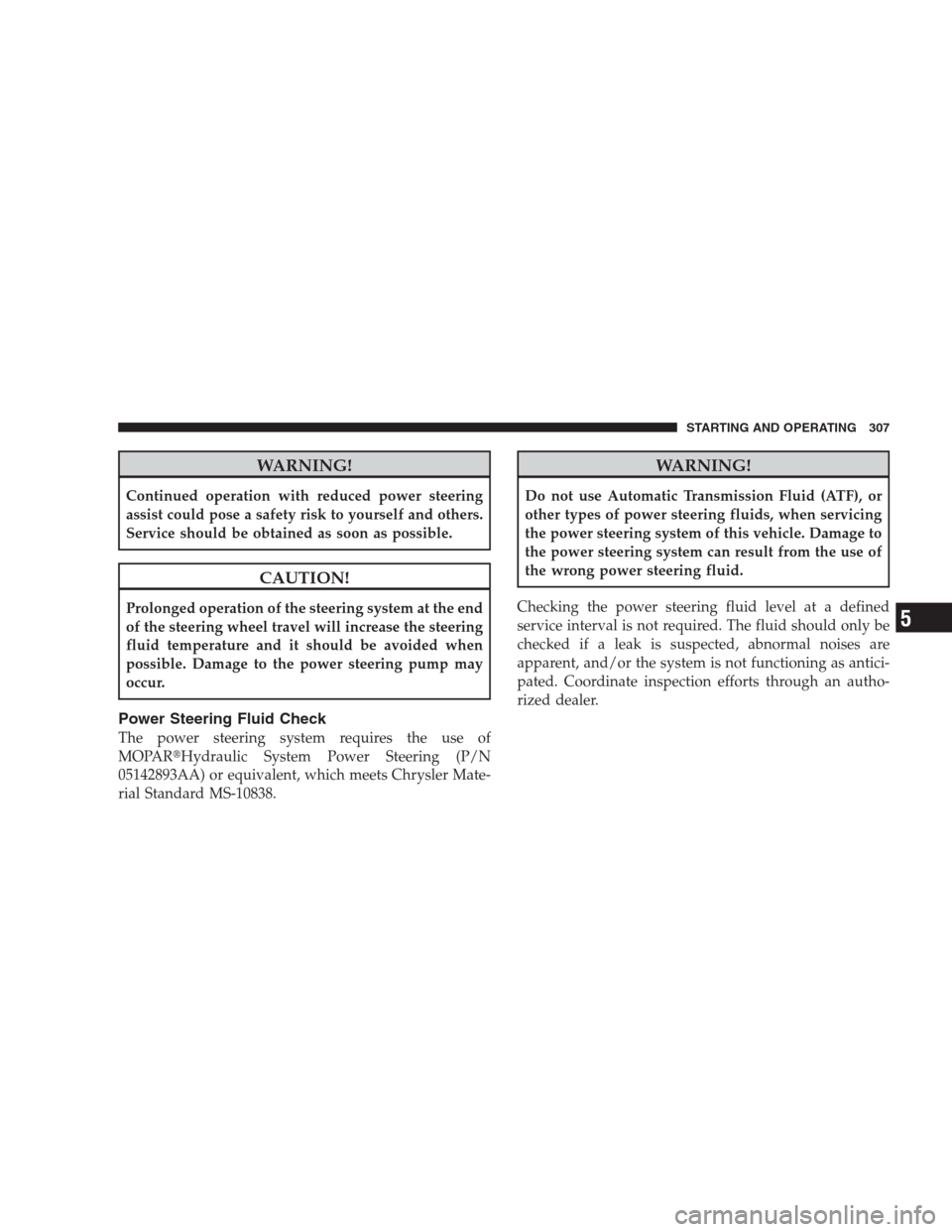
WARNING!
Continued operation with reduced power steering
assist could pose a safety risk to yourself and others.
Service should be obtained as soon as possible.
CAUTION!
Prolonged operation of the steering system at the end
of the steering wheel travel will increase the steering
fluid temperature and it should be avoided when
possible. Damage to the power steering pump may
occur.
Power Steering Fluid Check
The power steering system requires the use of
MOPAR�Hydraulic System Power Steering (P/N
05142893AA) or equivalent, which meets Chrysler Mate-
rial Standard MS-10838.
WARNING!
Do not use Automatic Transmission Fluid (ATF), or
other types of power steering fluids, when servicing
the power steering system of this vehicle. Damage to
the power steering system can result from the use of
the wrong power steering fluid.
Checking the power steering fluid level at a defined
service interval is not required. The fluid should only be
checked if a leak is suspected, abnormal noises are
apparent, and/or the system is not functioning as antici-
pated. Coordinate inspection efforts through an autho-
rized dealer.
STARTING AND OPERATING 307
5
Page 310 of 521
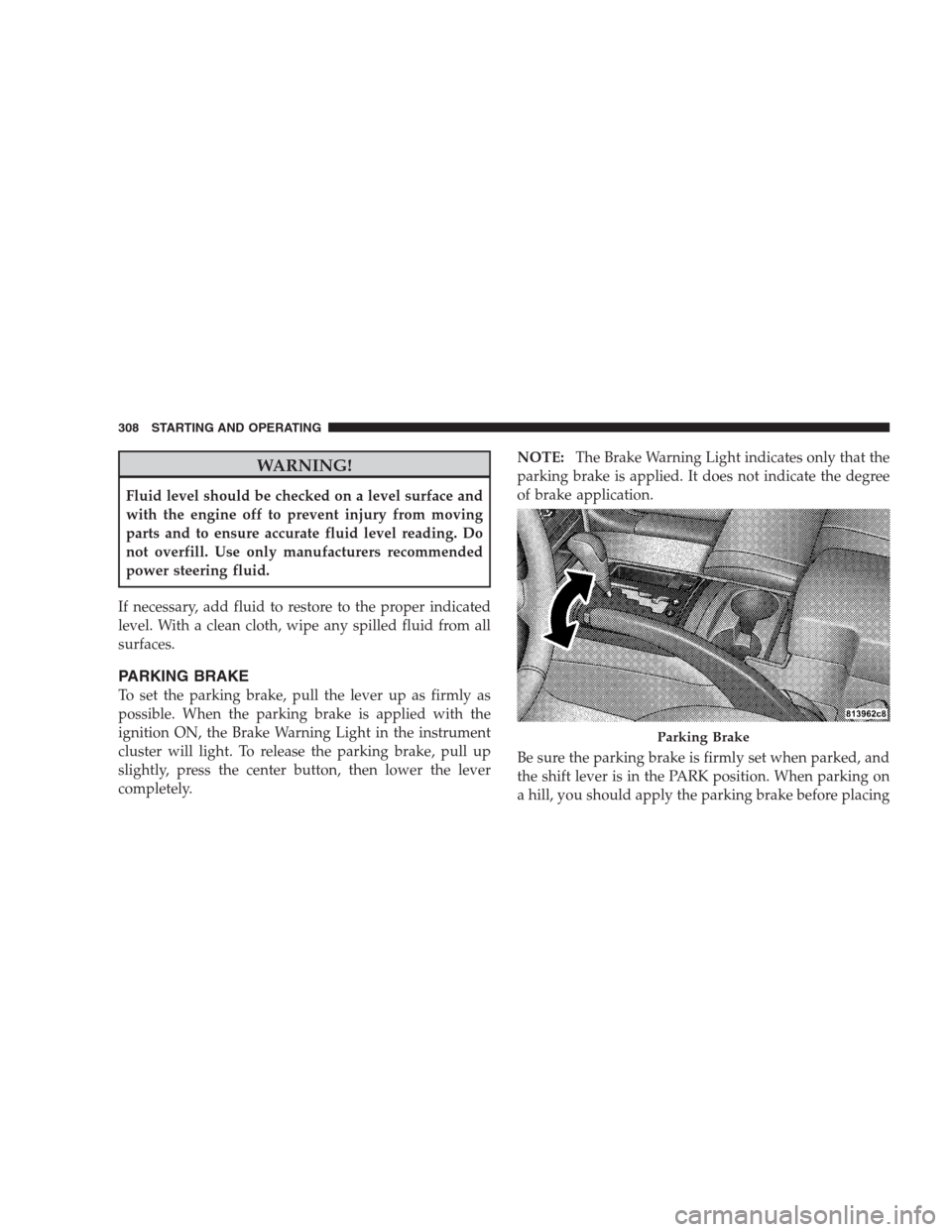
WARNING!
Fluid level should be checked on a level surface and
with the engine off to prevent injury from moving
parts and to ensure accurate fluid level reading. Do
not overfill. Use only manufacturers recommended
power steering fluid.
If necessary, add fluid to restore to the proper indicated
level. With a clean cloth, wipe any spilled fluid from all
surfaces.
PARKING BRAKE
To set the parking brake, pull the lever up as firmly as
possible. When the parking brake is applied with the
ignition ON, the Brake Warning Light in the instrument
cluster will light. To release the parking brake, pull up
slightly, press the center button, then lower the lever
completely.NOTE:The Brake Warning Light indicates only that the
parking brake is applied. It does not indicate the degree
of brake application.
Be sure the parking brake is firmly set when parked, and
the shift lever is in the PARK position. When parking on
a hill, you should apply the parking brake before placing
Parking Brake
308 STARTING AND OPERATING
Page 462 of 521
Chassis
Component Fluid, Lubricant, or Genuine Part
Automatic Transmission MOPAR�ATF+4 Automatic Transmission Fluid
Transfer Case (NV140 Single Speed
Only)MOPAR�ATF+4 Automatic Transmission Fluid
Transfer Case (NV245 Two Speed
Only)MOPAR�NV 247/245 Transfer Case Lubricant
Axle Differential (Front-Rear) MOPAR�Synthetic Gear & Axle Lubricant SAE 75W-140 (API-GL5) or
equivalent with friction modifier additive.
Brake Master Cylinder MOPAR�DOT 3 Brake Fluid, SAE J1703 should be used. If DOT 3, SAE
J1703 brake fluid is not available, then DOT 4 is acceptable. Use only rec-
ommended brake fluids.
Power Steering Reservoir This system requires the use of MOPAR�Hydraulic System Power Steer-
ing Fluid (P/N 05142893AA) or equivalent, which meets Chrysler Material
Standard MS-10838.
460 MAINTAINING YOUR VEHICLE
Page 465 of 521
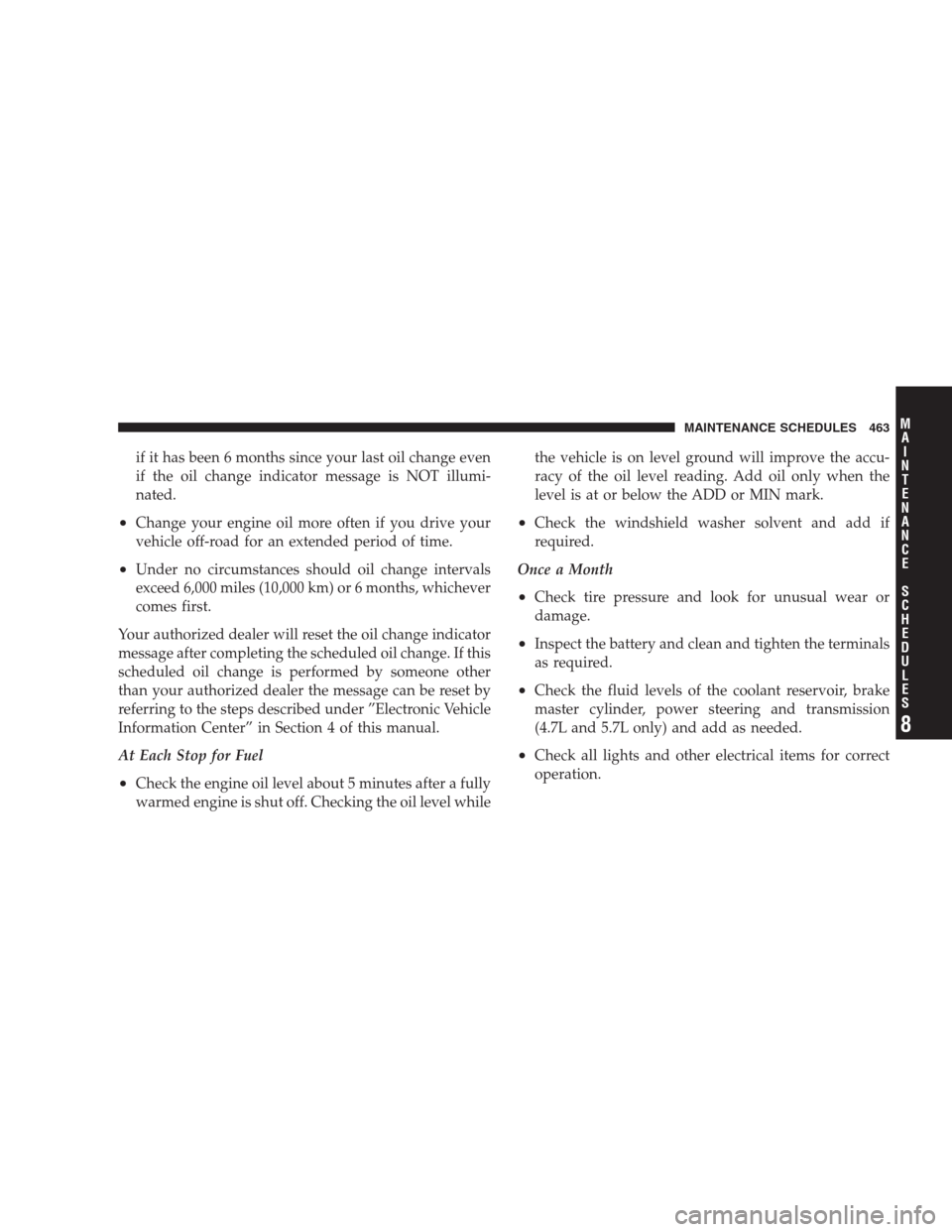
if it has been 6 months since your last oil change even
if the oil change indicator message is NOT illumi-
nated.
•Change your engine oil more often if you drive your
vehicle off-road for an extended period of time.
•Under no circumstances should oil change intervals
exceed 6,000 miles (10,000 km) or 6 months, whichever
comes first.
Your authorized dealer will reset the oil change indicator
message after completing the scheduled oil change. If this
scheduled oil change is performed by someone other
than your authorized dealer the message can be reset by
referring to the steps described under ”Electronic Vehicle
Information Center” in Section 4 of this manual.
At Each Stop for Fuel
•Check the engine oil level about 5 minutes after a fully
warmed engine is shut off. Checking the oil level whilethe vehicle is on level ground will improve the accu-
racy of the oil level reading. Add oil only when the
level is at or below the ADD or MIN mark.
•Check the windshield washer solvent and add if
required.
Once a Month
•Check tire pressure and look for unusual wear or
damage.
•Inspect the battery and clean and tighten the terminals
as required.
•Check the fluid levels of the coolant reservoir, brake
master cylinder, power steering and transmission
(4.7L and 5.7L only) and add as needed.
•Check all lights and other electrical items for correct
operation.
MAINTENANCE SCHEDULES 463
8
M
A
I
N
T
E
N
A
N
C
E
S
C
H
E
D
U
L
E
S
Page 479 of 521
•Check the windshield washer solvent and add if
required.
Once a Month
•Check tire pressure and look for unusual wear or
damage.
•Inspect the battery and clean and tighten the terminals
as required.
•Check the fluid levels of the coolant reservoir, brake
master cylinder, and power steering and add as
needed.
•Check all lights and other electrical items for correct
operation.
At Each Oil Change
•Change the engine oil filter.
•Inspect the brake hoses and lines.
•Inspect for the presence of water in the fuel filter/
water separator unit.
CAUTION!
Failure to perform the required maintenance items
may result in damage to the vehicle.
Required Maintenance Intervals
Refer to the Maintenance Schedules on the following
pages for the required maintenance intervals.
MAINTENANCE SCHEDULES 477
8
M
A
I
N
T
E
N
A
N
C
E
S
C
H
E
D
U
L
E
S